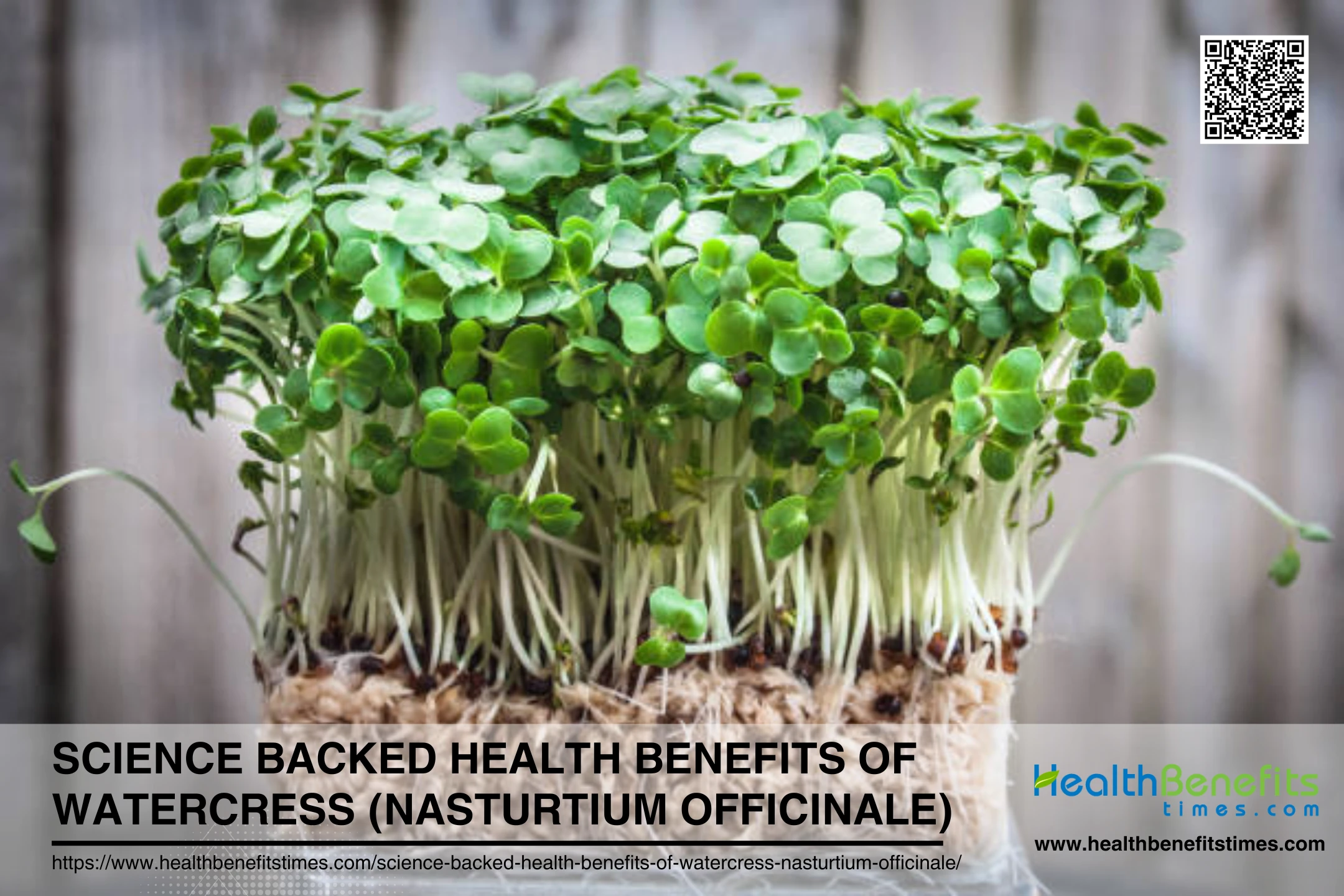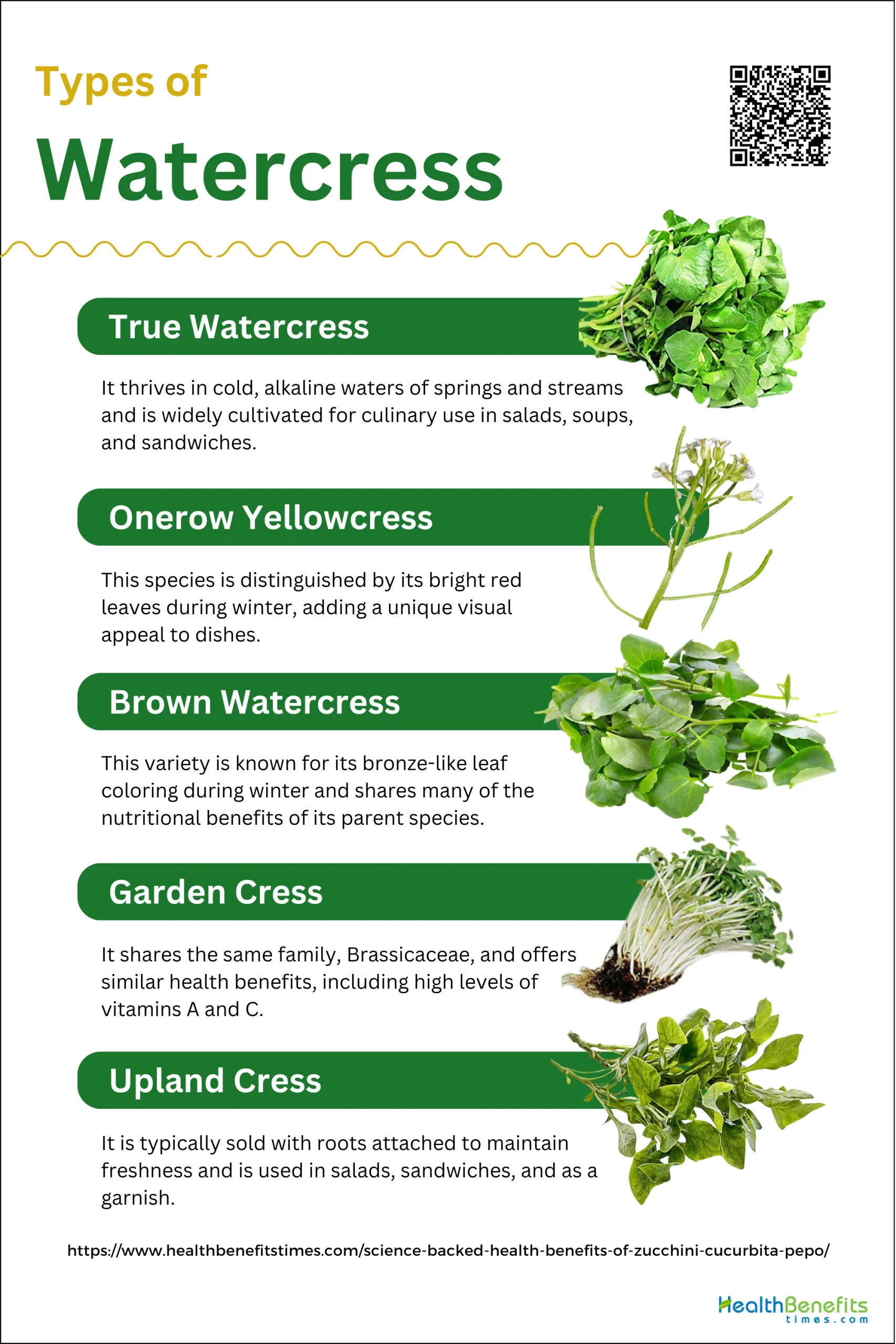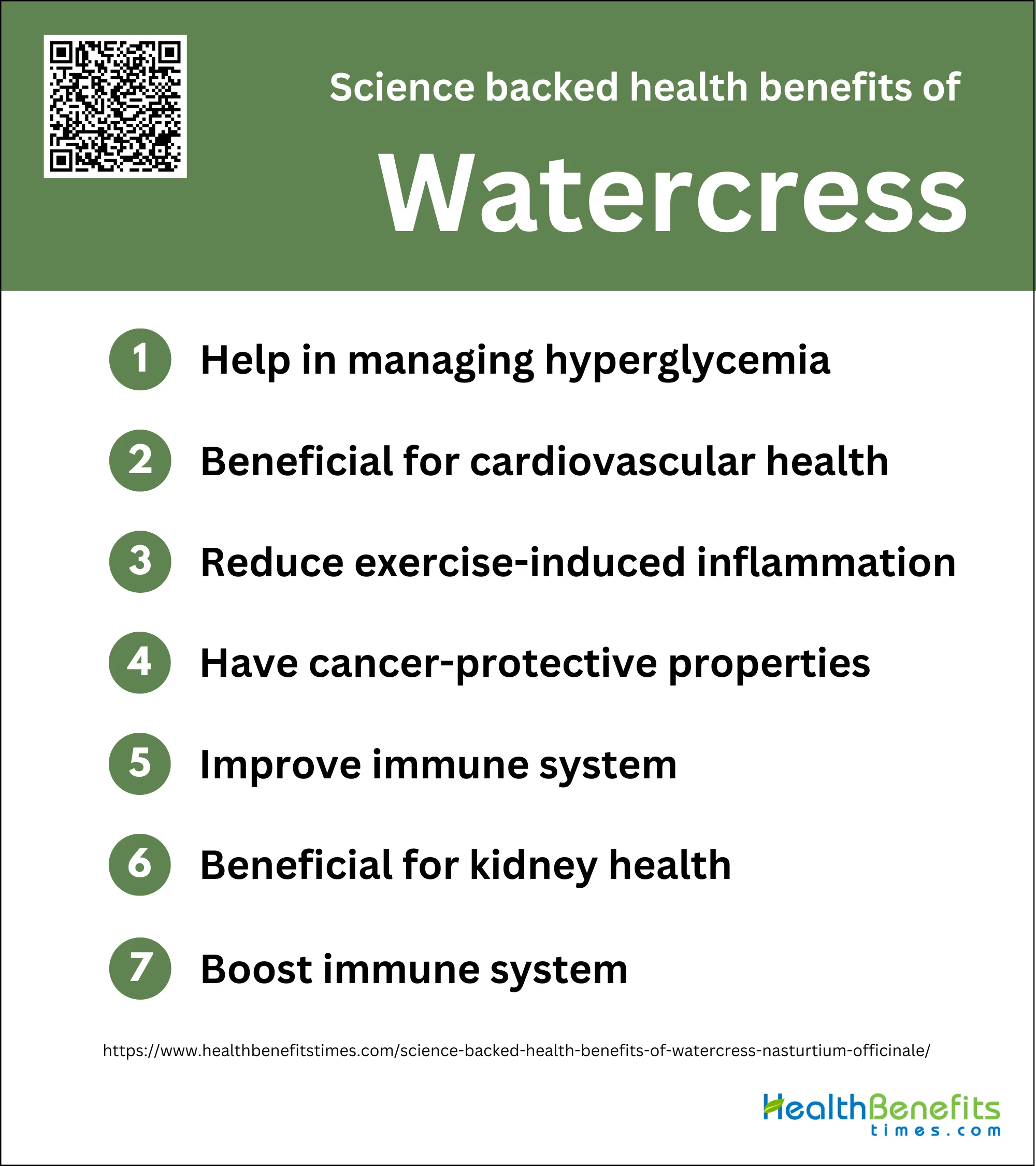- Watercress is a nutrient-rich, cancer-protective, phytoremediation, antioxidants, vitamins, minerals, phytochemicals.
- Watercress varieties are nutrient-rich, peppery flavors, diverse, versatile, unique characteristics, visual appeal.
- Watercress is nutrient-dense, antioxidant-rich, anti-cancer, cardiovascular benefits, reduces inflammation, manages hyperglycemia.
- Watercress is cancer-protective, immune-boosting, antioxidant-rich, kidney health, reduces inflammation.
- Watercress boosts immune system, rich in vitamins A and C, antioxidants.
- Watercress has potential medication interactions, digestive issues, risks for pregnant women, kidney concerns, allergies.
 Watercress (Nasturtium officinale) is more than just a peppery addition to your salad; it’s a powerhouse of nutrients backed by science. This aquatic plant, often found in European and Asian water sources, is packed with vitamins, minerals, and antioxidants that offer numerous health benefits. From supporting heart health to enhancing bone density and boosting the immune system, watercress is a versatile leafy green that can significantly contribute to overall well-being. Its rich content of vitamins A, C, and K, along with essential minerals like calcium and magnesium, makes it a nutrient-dense food with potential therapeutic effects. Whether you’re looking to lower blood pressure, improve eye health, or reduce oxidative stress, incorporating watercress into your diet can be a simple yet effective way to enhance your health.
Watercress (Nasturtium officinale) is more than just a peppery addition to your salad; it’s a powerhouse of nutrients backed by science. This aquatic plant, often found in European and Asian water sources, is packed with vitamins, minerals, and antioxidants that offer numerous health benefits. From supporting heart health to enhancing bone density and boosting the immune system, watercress is a versatile leafy green that can significantly contribute to overall well-being. Its rich content of vitamins A, C, and K, along with essential minerals like calcium and magnesium, makes it a nutrient-dense food with potential therapeutic effects. Whether you’re looking to lower blood pressure, improve eye health, or reduce oxidative stress, incorporating watercress into your diet can be a simple yet effective way to enhance your health.
What is Watercress ?
Watercress is an aquatic leafy vegetable belonging to the Brassicaceae family, renowned for its high nutritional value and medicinal properties. It is a rich source of glucosinolates, particularly gluconasturtiin, which hydrolyzes to produce phenethyl isothiocyanate (PEITC), a compound known for its protective effects against cancers associated with tobacco-specific carcinogens. The plant’s chloroplast genome has been sequenced, revealing a typical quadripartite structure and providing valuable resources for future evolutionary and genetic studies. Watercress also contains significant levels of polyphenolics, carotenoids, and other secondary metabolites, which contribute to its health-promoting properties. Additionally, it has been shown to accumulate arsenic and exhibit biological responses to arsenic stress, indicating its potential for phytoremediation. The plant’s volatile organic compounds (VOCs) have demonstrated nematicidal activity, suggesting potential applications in pest management. Overall, watercress is not only a nutrient-dense food but also a plant with diverse applications in health and environmental sustainability.
Nutritional Profile of Watercress
Watercress is a nutrient-dense aquatic vegetable that packs a powerful nutritional punch despite its low calorie content. This leafy green, belonging to the Brassicaceae family, is rich in essential vitamins, minerals, antioxidants, and phytochemicals, making it a valuable addition to a healthy diet. With just 4 calories per cup (34g), watercress provides a significant amount of vital nutrients while being virtually fat-free and low in carbohydrates.
Overview: Discuss the rich nutritional content of Watercress.
Watercress boasts an impressive nutritional profile, offering a wide array of essential nutrients in a low-calorie package. This aquatic vegetable is particularly rich in vitamins A, C, and K, while also providing significant amounts of calcium, potassium, and magnesium. Additionally, watercress contains various antioxidants and phytochemicals, including beta-carotene, lutein, zeaxanthin, and glucosinolates, which contribute to its potential health benefits. Its nutrient density is so remarkable that it has been reported to rival other superfoods like kale, spinach, and Chinese cabbage in terms of nutritional value.
Vitamins: A, C, K, E, and several B vitamins
Watercress is an excellent source of several essential vitamins. It is particularly rich in vitamin K, with one cup providing 85 micrograms or 106% of the daily value (DV). Vitamin C is another standout nutrient in watercress, with a cup offering 14.6 mg or 24% of the DV. The vegetable is also a good source of vitamin A, primarily in the form of beta-carotene, providing 1,085 IU or 22% of the DV per cup. Additionally, watercress contains vitamin E and several B vitamins, including thiamin (B1), riboflavin (B2), niacin (B3), pantothenic acid (B5), and vitamin B6, albeit in smaller amounts.
Minerals: Calcium, Magnesium, Potassium, Iron
Watercress is a valuable source of essential minerals that play crucial roles in various bodily functions. It is particularly noteworthy for its calcium content, providing 40.8 mg or 3% of the DV per cup, which contributes to bone health. Magnesium and potassium are also present in significant amounts, with 7.1 mg (2% DV) and 112.2 mg (2% DV) per cup, respectively. These minerals are important for maintaining healthy blood pressure levels and supporting overall cardiovascular health. While iron is present in watercress, it is in relatively small amounts, with 0.07 mg per cup.
Antioxidants: Beta-carotene, Lutein, Zeaxanthin
Watercress is rich in antioxidants, which help protect the body against oxidative stress and cellular damage. Beta-carotene, a precursor to vitamin A, is abundant in watercress, with 650.8 mcg per cup. This antioxidant is known for its role in supporting eye health and immune function. Lutein and zeaxanthin, two carotenoids crucial for eye health, are also present in significant amounts, with 1960.8 mcg combined per cup. These antioxidants have been linked to a reduced risk of chronic diseases, including certain cancers and cardiovascular conditions.
Phytochemicals: Glucosinolates
Watercress contains important phytochemicals, particularly glucosinolates, which are sulfur-containing compounds characteristic of cruciferous vegetables. When consumed, glucosinolates break down into bioactive compounds such as isothiocyanates, including phenylethyl isothiocyanate (PEITC). These compounds are responsible for the peppery flavor of watercress and have been associated with various potential health benefits, including anti-inflammatory and anti-cancer properties. The presence of these phytochemicals contributes to the overall nutritional value and potential therapeutic effects of watercress.
Types of Watercress
When it comes to adding a peppery punch to your dishes, watercress is a versatile and nutrient-rich choice. However, did you know there are several varieties of this leafy green, each with its own unique characteristics? From the classic Nasturtium officinale, known for its robust flavor and high nutrient content, to the visually striking Nasturtium microphyllum with its bright red winter leaves, watercress comes in many forms. There’s also the hybrid Nasturtium x sterile, and related greens like garden cress (Lepidium sativum) and upland cress (Barbarea verna), which offer similar health benefits and culinary uses. Dive into the world of watercress varieties and discover the distinctive traits that make each one a valuable addition to your diet.
1. True Watercress (Nasturtium officinale)
Nasturtium officinale, commonly known as true watercress, is a fast-growing, aquatic perennial herb native to Europe and Asia. It is characterized by hollow stems, pinnately compound leaves, and small white flowers. True watercress is highly valued for its peppery flavor and rich nutritional profile, including vitamins A, C, and K, as well as calcium and iron. It thrives in cold, alkaline waters of springs and streams and is widely cultivated for culinary use in salads, soups, and sandwiches.
2. Onerow Yellowcress (Nasturtium microphyllum)
Nasturtium microphyllum, also known as onerow yellowcress or brown/winter watercress, is a closely related species to true watercress. It is smaller and more compact, with stems that can grow up to 90 centimeters long. This species is distinguished by its bright red leaves during winter, adding a unique visual appeal to dishes. Like its relative, onerow yellowcress is rich in nutrients and is often used in similar culinary applications.
3. Brown Watercress (Nasturtium x sterile)
Nasturtium x sterile is an infertile hybrid between Nasturtium officinale and Nasturtium microphyllum. This variety is known for its bronze-like leaf coloring during winter and shares many of the nutritional benefits of its parent species. Brown watercress is less commonly found in the wild but can be cultivated for its unique aesthetic and flavor profile, making it a desirable addition to various dishes.
4. Garden Cress (Lepidium sativum)
Though not a true watercress, Lepidium sativum, known as garden cress, is a popular relative. It is an annual herb with a peppery flavor, often used in salads and as a garnish. Garden cress is easy to grow and can be harvested quickly, making it a favorite among home gardeners. It shares the same family, Brassicaceae, and offers similar health benefits, including high levels of vitamins A and C.
5. Upland Cress (Barbarea verna)
Barbarea verna, or upland cress, is another related variety often mistaken for watercress due to its similar flavor and appearance. Unlike true watercress, upland cress is not aquatic and grows well in moist, well-drained soils. It is typically sold with roots attached to maintain freshness and is used in salads, sandwiches, and as a garnish. Upland cress is noted for its tender stems and leaves, making it a versatile ingredient in various culinary applications.
Science backed health benefits of Watercress
Watercress is not just a flavorful addition to your salads; it’s a powerhouse of nutrition with a myriad of health benefits backed by scientific research. This leafy green is packed with essential vitamins and minerals, including vitamins A, C, and K, calcium, and iron, making it a nutrient-dense food choice. Beyond its basic nutritional profile, watercress is rich in antioxidants like beta-carotene, lutein, and zeaxanthin, which help combat oxidative stress and inflammation. Additionally, the presence of phytochemicals such as glucosinolates contributes to its potential anti-cancer properties. Whether you’re looking to boost your immune system, support bone health, or improve cardiovascular wellness, watercress offers a range of science-backed health benefits that make it a valuable addition to any diet.
1. Help in managing hyperglycemia
Watercress has shown promising potential in managing hyperglycemia, particularly in diabetic conditions. Research indicates that the ethanolic and aqueous extracts of watercress possess significant hypoglycemic effects. These extracts help reduce blood glucose levels by enhancing insulin secretion and improving the function of pancreatic beta cells, which are responsible for insulin production. Additionally, the high antioxidant content in watercress, including phenolic compounds and flavonoids, helps mitigate oxidative stress, a common issue in diabetes that exacerbates hyperglycemia. Studies on diabetic rats have demonstrated that watercress extract can significantly lower blood glucose levels and improve overall antioxidant status, supporting its use as a complementary treatment for diabetes management.
What Research Says?
- Watercress extract significantly reduces serum glucose levels in streptozotocin-induced diabetic rats, indicating its potential as a hypoglycemic agent.
- Watercress extracts contain high concentrations of phenols, polyphenols, and flavonoids, which contribute to its strong antioxidant effects. These properties help reduce oxidative stress and improve biochemical parameters in diabetic rats.
- In a randomized, double-blind, placebo-controlled trial, watercress extract supplementation improved LDL cholesterol and lipid peroxidation levels in overweight individuals, although it did not significantly change total serum cholesterol and HDL levels.
- Watercress has been traditionally used for its hypoglycemic properties, and systematic reviews of preclinical studies support its role in managing hyperglycemia and other chronic conditions.
2. Beneficial for cardiovascular health
Watercress is highly beneficial for cardiovascular health due to its rich nutrient and antioxidant profile. This leafy green is packed with dietary nitrates, which have been shown to improve blood vessel function by reducing inflammation and decreasing the stiffness and thickness of blood vessels. These nitrates help increase nitric oxide levels in the blood, leading to lower blood pressure and improved overall cardiovascular function. Additionally, watercress is abundant in antioxidants such as beta-carotene, lutein, and zeaxanthin, which protect against oxidative stress and reduce the risk of heart disease. Watercress can help lower cholesterol levels, further enhancing heart health by reducing bad LDL cholesterol and increasing good HDL cholesterol.
What Research Says?
- Watercress extract supplementation significantly improved low-density lipoprotein (LDL) cholesterol levels and lipid peroxidation in overweight individuals with physical disabilities.
- Watercress contains glucosinolates, isothiocyanates, polyphenols, terpenes, vitamins, and bioelements, which contribute to its antioxidant and cardioprotective effects.
- Acute toxicity studies in mice showed that watercress extract did not cause mortality, although high doses led to some histopathological changes in the liver, kidneys, and heart.
3. Reduce exercise-induced inflammation

Another study involving 10 healthy males demonstrated that both short-term (2 hours before exercise) and long-term (8 weeks) supplementation with watercress decreased exercise-induced inflammation markers. Furthermore, a more recent investigation with 19 healthy subjects observed that consuming a single serving (85 grams) of watercress after a 30-minute high-intensity workout led to higher anti-inflammatory markers compared to the control group. The anti-inflammatory effects of watercress are attributed to its rich content of antioxidants, including beta-carotene, vitamin C, and phenolic compounds, as well as its glucosinolates, which break down into bioactive isothiocyanates. These compounds help neutralize free radicals produced during intense physical activity and modulate inflammatory responses, potentially improving recovery and reducing muscle damage associated with exercise.
What Research Says?
- Watercress consumption before exercise leads to a stronger pro-inflammatory response initially but results in a more pronounced anti-inflammatory downregulation of cytokines IL-6 and TNF-α during the recovery phase.
- Standardized extract of watercress (SENO) decreases biomarkers of oxidative stress and inflammation, such as lipid peroxidation, protein carbonyl, catalase, superoxide dismutase, and C-reactive protein in people with physical disabilities.
- Watercress extract reduces chronic inflammation in animal models by decreasing IL-1β levels and inhibiting leukocyte infiltration, although it does not affect TNF-α levels.
- Watercress extract effectively reduces skin inflammation induced by croton oil in mice through glucocorticoid receptor-dependent and NF-κB pathways, without causing toxicological effects.
4. Have cancer-protective properties
Watercress has garnered significant attention for its potential cancer-protective properties. This cruciferous vegetable is rich in phenylethyl isothiocyanate (PEITC), a compound known for its ability to inhibit carcinogenesis. Watercress can interfere with the growth and proliferation of cancer cells, including breast, colon, and prostate cancers, by inducing apoptosis and reducing DNA damage. Daily consumption of watercress significantly decreased DNA damage in blood cells, a known trigger for cancer development, and enhanced the cells’ resistance to oxidative stress. Additionally, watercress’s high antioxidant content, including beta-carotene and lutein, further contributes to its anti-cancer effects by neutralizing free radicals and reducing inflammation.
What Research Says?
- Watercress is a rich source of glucosinolates, particularly gluconasturtiin, which hydrolyzes to produce PEITC, a compound known for its cancer-protective properties.
- PEITC from watercress inhibits the activation of carcinogens, such as those found in tobacco, by interfering with enzymes like Cytochrome P450, thereby reducing the risk of cancer, including oral cancer.
- Genetic transformation techniques, such as using Agrobacterium rhizogenes, have been developed to enhance the production of glucosinolates in watercress, potentially increasing its anticancer properties.
5. Improve immune system
Watercress has shown to have significant benefits for improving the immune system. This nutrient-dense leafy green is particularly rich in vitamin C, with one cup providing 24% of the recommended daily intake. Vitamin C is renowned for its immune-boosting properties, as it increases the production of white blood cells that fight infections. Additionally, watercress contains high levels of vitamin A, with 100g providing more than half of the recommended daily intake. Vitamin A is crucial for maintaining a strong immune system and enhancing iron absorption. The plant also contains numerous antioxidants, including beta-carotene and flavonoids, which help combat oxidative stress and inflammation, further supporting immune function. Watercress consumption found that it stimulates the immune system, potentially enhancing its metabolic capacity.
What Research Says?
- Watercress consumption can lead to a mild pro-inflammatory response initially, followed by a stronger anti-inflammatory downregulation during the recovery phase after exercise.
- Watercress extract has been shown to reduce biomarkers of oxidative stress and inflammation, such as lipid peroxidation and C-reactive protein, in people with physical disabilities.
- Preclinical studies in animals indicate that watercress can improve immune system parameters, including increased lysozyme and complement activities, and higher levels of total protein and globulin.
6. Beneficial for kidney health

Watercress shows benefits for kidney health, though more research is needed to fully establish its effects. Watercress may have protective properties for the kidneys due to its high antioxidant content, including compounds like phenylethyl isothiocyanate (PEITC) and flavonoids. These antioxidants can help combat oxidative stress and inflammation in the kidneys. Additionally, watercress is a good source of vitamins A and C, which support overall kidney function. However, it’s important to note that individuals with existing kidney disease should consult their healthcare provider before adding watercress to their diet, as its high vitamin K content may interact with certain medications, and its mineral content (including potassium) may need to be monitored in those with impaired kidney function.
What Research Says?
- Nasturtium officinale extract showed some preventive effects on renal stone formation in rats, particularly at low doses, though it did not significantly affect urinary and chemical parameters related to calcium oxalate stone crystals.
- In rats exposed to CCl4, Nasturtium officinale extract significantly decreased serum levels of BUN, creatinine, and other markers of kidney damage, suggesting its potential in ameliorating chemically induced renal toxicity.
- In a clinical trial, Nasturtium officinale extract improved antioxidant parameters and reduced serum levels of malondialdehyde (MDA) and blood urea nitrogen (BUN) in hemodialysis patients. It also prevented the elevation of LDL and triglycerides, although these changes were not statistically significant.
7. Boost immune system
Watercress is a potent immune system booster, thanks to its rich nutritional profile. This leafy green is packed with vitamin C, providing about 24% of the recommended daily intake in just one cup. Vitamin C is crucial for stimulating the production and function of white blood cells, which are essential for fighting off infections and diseases. Additionally, watercress contains significant amounts of vitamin A, another key nutrient for maintaining a robust immune system. The high levels of antioxidants in watercress, including beta-carotene and flavonoids, help combat oxidative stress and reduce inflammation, further supporting immune function. Research has shown that regular consumption of watercress can enhance the body’s immune response, potentially improving its ability to ward off illnesses. Moreover, the presence of glucosinolates in watercress, which break down into compounds like isothiocyanates, may have additional immune-modulating effects.
What Research Says?
- Watercress consumption can lead to a mild pro-inflammatory response initially, followed by a stronger anti-inflammatory downregulation during the recovery phase after exercise.
- Watercress extract has been shown to decrease biomarkers of oxidative stress and inflammation, such as lipid peroxidation and C-reactive protein, in people with physical disabilities.
- Preclinical studies in animals indicate that watercress can improve immune system function, showing positive effects on immune parameters and anti-inflammatory activity.
- In fish, oral administration of watercress extract enhanced several hematological and immunological parameters, including hemoglobin, mean corpuscular hemoglobin concentration, lysozyme, and complement activities.
How to Incorporate Watercress into Your Diet

Watercress, the peppery powerhouse of the leafy green world, is not just a garnish to be pushed aside on your plate. This nutrient-dense vegetable is packed with vitamins, minerals, and antioxidants, making it a fantastic addition to any health-conscious diet. But if you’re wondering how to make the most of this versatile green beyond the occasional salad, you’re in for a treat. From smoothies to soups, sandwiches to stir-fries, watercress can add a zesty kick and a nutritional boost to a wide variety of dishes. In this article, we’ll explore creative and delicious ways to incorporate watercress into your daily meals, helping you reap its health benefits while tantalizing your taste buds. Get ready to transform this often-overlooked green into a star ingredient in your culinary repertoire!
Salads: Easy and Delicious Salad Recipes
Incorporating watercress into your salads is a simple and delicious way to enjoy its numerous health benefits. One popular recipe is a watercress and pear salad, which combines the peppery flavor of watercress with the sweetness of ripe pears, toasted walnuts, and crumbled blue cheese, all drizzled with a light vinaigrette. Another easy option is a classic watercress salad with cherry tomatoes, red onion, and a tangy lemon dressing. For a heartier meal, try a watercress and quinoa salad with roasted vegetables and a tahini dressing. These recipes not only highlight the unique flavor of watercress but also provide a nutrient-packed meal that is both satisfying and healthy.
Smoothies: Nutrient-Packed Smoothie Ideas
Adding watercress to your smoothies is an excellent way to boost their nutritional content without compromising on taste. A green detox smoothie can be made by blending watercress with spinach, cucumber, green apple, and a splash of lemon juice for a refreshing and detoxifying drink. For a more tropical twist, try a watercress and pineapple smoothie with coconut water, banana, and a handful of mint leaves. Another option is a berry and watercress smoothie, combining watercress with mixed berries, Greek yogurt, and a touch of honey for a creamy and antioxidant-rich beverage. These nutrient-packed smoothies are perfect for breakfast or a post-workout snack.
Soups and Sandwiches: Creative Ways to Include Watercress in Meals
Watercress can be creatively incorporated into soups and sandwiches to add a peppery kick and boost their nutritional value. For soups, a classic watercress soup can be made by sautéing onions and garlic, adding potatoes and vegetable broth, and then blending in fresh watercress until smooth. This soup can be served hot or cold, making it versatile for any season. In sandwiches, watercress pairs wonderfully with ingredients like smoked salmon, cream cheese, and thinly sliced cucumber for a refreshing and elegant option. Another idea is a grilled cheese sandwich with watercress and sharp cheddar, which adds a delightful crunch and a burst of flavor. These creative uses of watercress can elevate everyday meals into something special.
Side Effects of Eating Watercress
While watercress is renowned for its impressive nutritional profile and potential health benefits, it’s important to be aware that consuming this peppery green can have some unexpected side effects for certain individuals. From potential interactions with medications to digestive issues, watercress isn’t without its risks. Whether you’re a health enthusiast looking to incorporate more superfoods into your diet or simply curious about this leafy green, understanding the potential drawbacks of watercress consumption is crucial. In this article, we’ll explore the lesser-known side effects of eating watercress, helping you make informed decisions about including it in your meals and ensuring you reap its benefits safely.
Pregnancy and Breast-Feeding
Watercress is generally considered unsafe for pregnant and breastfeeding women when consumed in medicinal amounts. It has the potential to stimulate menstruation and may cause a miscarriage, posing a significant risk during pregnancy. Additionally, there is insufficient information about its safety during breastfeeding, so it is advisable to avoid its use to prevent any possible adverse effects on both the mother and the baby.
Stomach or Intestinal Ulcers
Individuals with stomach or intestinal ulcers should avoid consuming watercress. The compounds in watercress can irritate the stomach lining and exacerbate existing ulcers, leading to increased discomfort and potential complications. It is crucial for those with gastrointestinal issues to consult their healthcare provider before adding watercress to their diet.
Kidney Disease
People with kidney disease should exercise caution when consuming watercress. Large amounts of watercress can lead to kidney problems due to its high levels of certain minerals and compounds that may exacerbate kidney conditions. It is advisable for individuals with kidney disease to avoid watercress or consult their healthcare provider before including it in their diet.
Interaction with Blood Thinners
Watercress is high in vitamin K, which plays a crucial role in blood clotting. This can interfere with blood-thinning medications such as warfarin (Coumadin), potentially reducing their effectiveness. Individuals on blood thinners should monitor their intake of watercress and maintain consistent vitamin K levels to avoid any adverse interactions. Consulting with a healthcare provider is recommended to manage vitamin K intake appropriately.
Potential Allergic Reactions
Though rare, some individuals may experience allergic reactions to watercress, which can include symptoms such as itching, swelling, or difficulty breathing. If an allergic reaction is suspected, it is important to seek medical attention immediately. Those with known allergies to related plants in the Brassicaceae family should exercise caution when consuming watercress.
Irritant Potential
Consuming large amounts of raw watercress may cause irritation due to the presence of mustard oils, which can be harsh on the digestive system. This can lead to symptoms such as stomach upset, bloating, or gas. It is advisable to introduce watercress gradually into the diet and consume it in moderate amounts to minimize the risk of irritation.
Foodborne Illness Risk
Like other leafy greens, watercress can be a source of foodborne illnesses if contaminated. It is essential to wash watercress thoroughly before consumption to remove any potential pathogens. Ensuring proper handling and storage can help reduce the risk of foodborne illness and ensure the safe consumption of watercress.
Conclusion
Watercress stands out as a remarkable aquatic vegetable, celebrated not only for its distinctive peppery flavor but also for its extensive health benefits supported by scientific evidence. Rich in essential vitamins such as A, C, and K, as well as vital minerals and antioxidants, watercress contributes significantly to overall health, including enhanced immune function, improved cardiovascular health, and potential cancer-protective properties. Its unique phytochemicals, particularly glucosinolates, may help combat oxidative stress and inflammation, making it a valuable addition to a balanced diet. Furthermore, emerging research suggests its role in managing conditions like hyperglycemia and promoting kidney health, highlighting watercress’s versatility as both a nutritious food and a therapeutic agent. Incorporating this nutrient-dense leafy green into daily meals can thus provide a simple yet effective way to boost health and well-being.
ADDITIONAL RESOURCES
Here is a list of US organizations related to research on green vegetables, along with their short descriptions and URLs:
1. University of California Agriculture and Natural Resources (UC ANR)
UC ANR conducts research and provides information on a wide variety of agricultural topics, including the cultivation and benefits of green vegetables.
2. American Society for Horticultural Science (ASHS)
ASHS promotes and encourages scientific research and education in all branches of horticulture, including the study of green vegetables.
3. Produce Marketing Association (PMA)
PMA supports the global produce and floral supply chains by providing research, education, and advocacy. It includes research on green vegetables to enhance industry practices.
4. International Fresh Produce Association (IFPA)
IFPA brings together the entire fresh produce and floral supply chain to advocate for the industry, including conducting and supporting research on green vegetables.
This nonprofit organization conducts and communicates scientific research about the benefits of organic food and farming, including organic green vegetables.
The Rodale Institute pioneers research on organic farming methods, including the cultivation of green vegetables, to promote healthy food and soil.
Recommendations for books on Watercress
Here are some recommended books on the research of Watercress, along with their links:
1. “Watercress: A Complete Guide to the Natural Superfood” by Barbara Pleasant
This book delves into the nutritional benefits and culinary uses of watercress, supported by research findings.
2. “Nutritional Composition and Antioxidant Properties of Fruits and Vegetables” by Amit K. Jaiswal (Chapter on Watercress)
This book covers the nutritional profile and health benefits of various fruits and vegetables, including a specific chapter on watercress.
3. “Handbook of Vegetables and Vegetable Processing” edited by Nirmal Sinha (Section on Watercress)
This comprehensive handbook includes a section dedicated to the processing and nutritional aspects of watercress.
FAQS
- What are the main nutritional components of watercress?
Watercress is rich in vitamins A, C, and K, as well as minerals like calcium, potassium, and magnesium. It also contains antioxidants such as beta-carotene, lutein, and zeaxanthin. - How does watercress contribute to heart health?
Watercress contains antioxidants and dietary nitrates that can help lower blood pressure, reduce inflammation, and decrease the stiffness of blood vessels. It may also help lower cholesterol levels. - Can watercress help in cancer prevention?
Studies suggest that compounds in watercress, particularly isothiocyanates, may have anti-cancer properties. Research has shown potential benefits in reducing DNA damage and suppressing cancer cell growth. - Does watercress have anti-inflammatory properties?
Yes, watercress has been shown to have anti-inflammatory effects, which can be beneficial for various health conditions. - How does watercress support bone health?
Watercress is rich in vitamin K, calcium, and other minerals essential for bone health. Regular consumption may help maintain bone density and reduce the risk of fractures. - Can watercress improve eye health?
Watercress contains lutein and zeaxanthin, antioxidants that are beneficial for eye health. These compounds may help protect against age-related macular degeneration. - Does watercress have benefits for skin health?
The high vitamin C content and antioxidants in watercress may help protect skin from oxidative stress and support collagen production, potentially slowing skin aging. - How does watercress affect the immune system?
Watercress is rich in vitamin C, which is known to boost immune function. It may help increase the production of white blood cells and reduce the duration of cold symptoms. - Can watercress help in weight management?
While not specifically studied for weight loss, watercress is a low-calorie, nutrient-dense food that can be a healthy addition to a weight management diet. - Are there any potential side effects or risks associated with consuming watercress?
While generally safe, watercress is high in vitamin K, which may interact with blood-thinning medications. It also contains goitrogens, which in large amounts could affect thyroid function in susceptible individuals.



